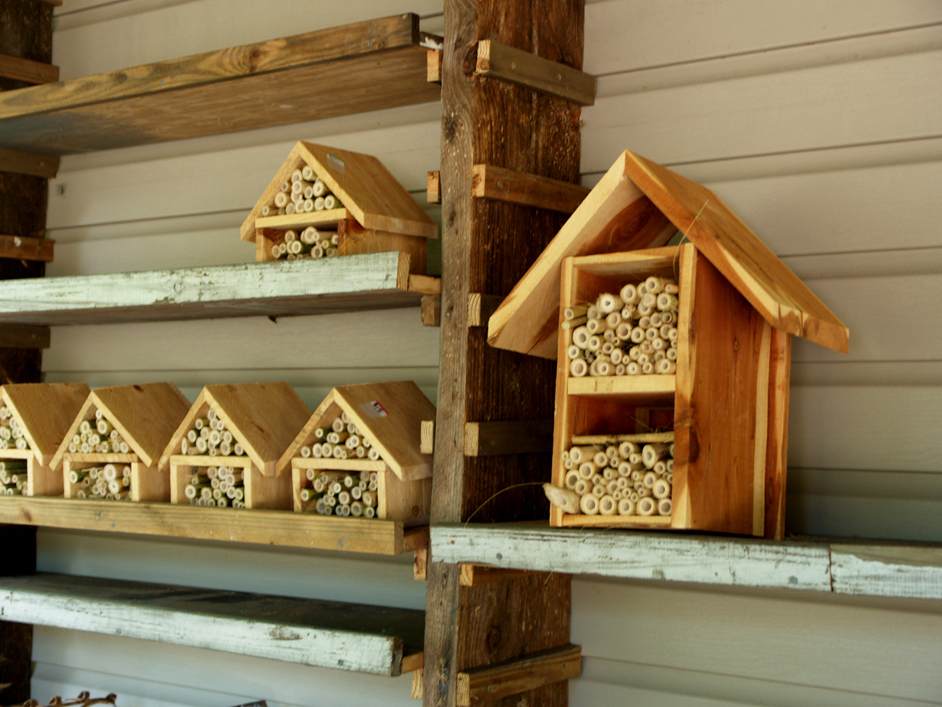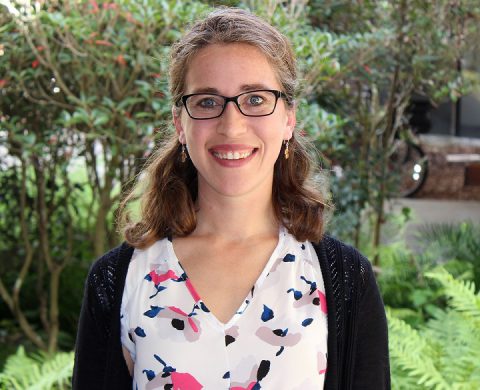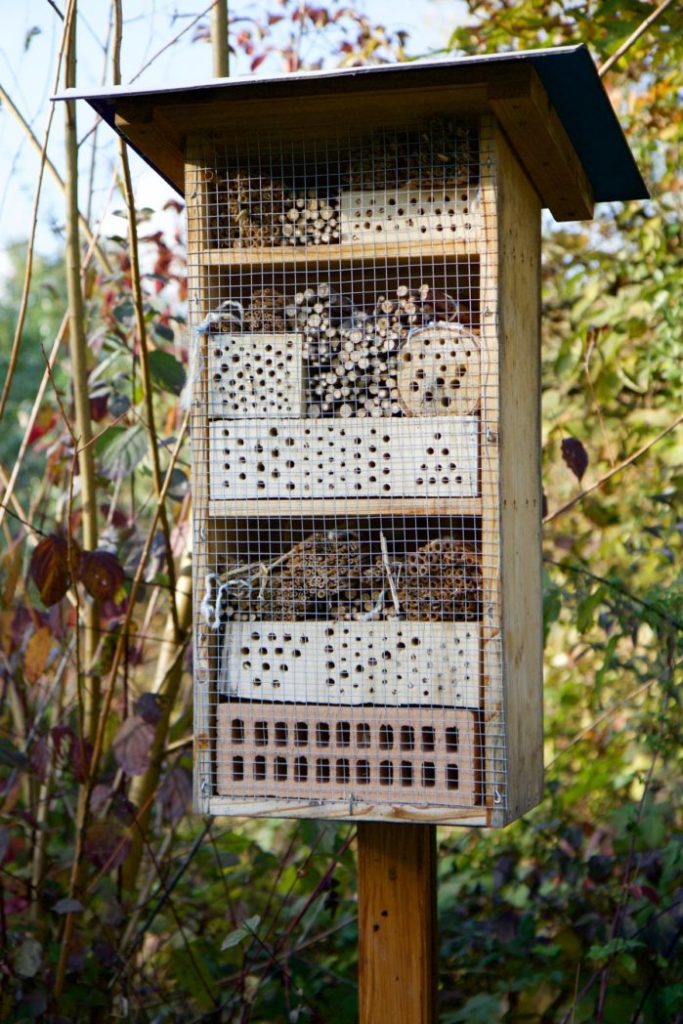Making a home for native bees
Florida has more than 300 species of native bees, which work alongside non-native honeybees to pollinate food crops. Native bees also are of paramount importance to the pollination of most of Florida’s flowering native plant species. However, many of these bees are declining rapidly due to habitat loss and degradation, pesticide use and our climate crisis.
To support these bees, it is more important than ever to make a home for them. We recently asked native bee expert Dr. Rachel Mallinger of the University of Florida for tips on welcoming them to urban landscapes.

Question: What is the best thing we can do to support native bees in our yards and gardens?
Dr. Rachel Mallinger: I tend to emphasize the provisioning of floral resources, as well as ground suitable for the majority of bees that nest below ground. Bare ground – or at least ground not covered in thick mulch or cloth barrier – is probably the best thing people can do for providing nesting habitat. It doesn’t have to be completely bare – it can have some leaves, pine needles, etc. – just not totally covered in thick mulch or impenetrable barrier.
Q: What about leaving small piles of brush and twigs in the landscape?
RM: Leaving rotting wood and brush around is a good idea for cavity nesters, but that’s probably the type of thing I would recommend to people managing large natural areas or with a lot of land, and not necessarily to those with small yards in an urban environment. But if you can do it, great!
Bee box or bare ground?
Q: What about incorporating a bee box or house?
RM: Many people use bee houses because they are more appealing than leaving bare ground around your home and they can add a decorative element to the landscape. But I think simply providing floral resources and leaving patches of bare ground is preferable both because the majority of bees nest below ground and also because bee houses can be hard to maintain.
Q: Lately we’ve read there may be a downside to using boxes. Can you shed some light on this?
RM: The concern is that diseases, pests and parasites can build up in these houses. There is not a lot of scientific research on this topic, but I do agree that it is a risk. Many bee boxes or bee homes also are not designed very well. And even when they are designed well, they may not be as attractive to bees as natural habitat.
If you are going to make or buy a bee home, use appropriately sized holes – 6 to 10 mm in diameter and at least 6 inches long. It is best to use homes that are made of local wood and to line the holes with paper straws or cardboard tubes that can be replaced yearly. Alternatively, you can use reeds that are bundled inside of a protective structure and replace the reeds yearly. If you are using wood blocks without liners, you can clean the cavities or replace the wood blocks themselves every three or so years.
Timing is everything
Q: For those using bee homes, is the timing of replacing the liners and reeds, or cleaning the blocks, important?
RM: It’s important, but not the most straightforward thing. You want to allow the bees from the previous year’s eggs to emerge, but you don’t want those same bees – or other bees in the area – to nest back inside the structure before you have replaced the liners and/or cleaned it. Since it is hard to get the timing just right – timing it for after bee emergence but before they have established nest sites – it may be best to put your reeds, liners, or the whole block into a structure, such as wooden or cardboard box, with a large hole at the top. Do this in late winter/early spring (February or March) before the bees emerge. This will allow bees to leave out the hole at the top, but they are unlikely to find their way back in to nest.
You can put out new reeds, blocks or liners around that same time for the emerged bees to nest in. If you are cleaning and reusing a structure, follow the above protocol, and after it seems that the bees have emerged (you see few remaining capped nests), clean the inside of the cavities and place the structure out again later that year or the following year.
When to clean
Q: When are adult bees likely to emerge so that the bee house can be cleaned?
A: This is a tricky question because so many different species can nest in these structures and they emerge at different times. The earliest bees will emerge in early spring, as early as late February in some parts of Florida. So if removing liners or reeds, you would want to do this by mid- to late February and put out clean or new structures shortly thereafter for the earliest bees to nest in.
Q. Some bee boxes feature hollow bamboo reeds instead of paper straws. Is it OK to use bamboo?
RM: If using bamboo, I would put the reeds out in smaller clusters that are spatially segregated instead of in just in one enormous cluster. Make sure there is some protective structure or overhang, and make sure the reeds are closed at the back – you’ll either put the reeds inside a tube with a closed back or plug one end of each reed. Replace reeds every year or so; again, this requires timing and some sort of system described above.
Q: Is bamboo the best reed to use?
RM: There is some concern that the commercially available bamboo isn’t as good for our native bees, but this may depend on where the bamboo is coming from and your management (if you can replace the reeds regularly). I have seen bees nest in bamboo, and know others who still recommend it as nesting habitat. In addition to bamboo, there are other types of reeds available, such as phragmites reeds. Keep in mind that the holes should be fairly small, 6 to 10 mm in diameter or even smaller for small bees. I see a lot of huge bamboo used in these nests, and that is not preferable for bees.
Bee box mounting
Q: What is the best way to mount a bee box or reed cluster?
RM: Make sure they are firmly attached to a stake, post, or tree – not swinging. Mount it so that it receives morning sun but is shaded in the afternoon. Make sure there is some sort of overhang for protection from rain.
Q: In Florida, what species of bees are apt to nest in bee boxes?
RM: Approximately 70 percent of native bees are ground-nesters, with about 30 percent preferring cavities. The most abundant and diverse group of above-ground nesters in Florida are the Leafcutter bees in the genus Megachile. Other bees that could nest in the homes are Mason bees in the genus Osmia. Less common or less diverse taxa that may utilize the structures include Leafcutter and Mason bees in the genera Hoplitis and Heriades, and the species Ashmeadiella floridana. Even Carpenter bees (Xylocopa spp.) will sometimes utilize pre-existing cavities.
Dr. Rachel Mallinger is an assistant professor in the University of Florida’s Department of Entomology and Nematology, where she specializes in native bees.


